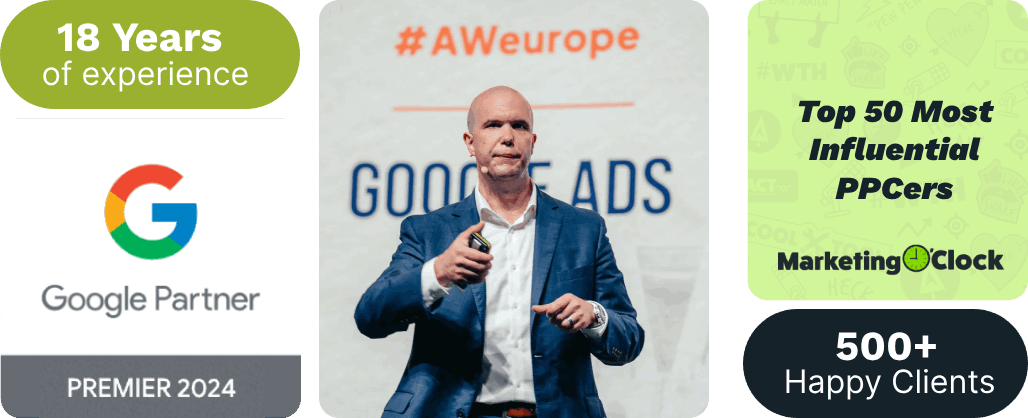Are you working with a limited ad budget but still interested in maximizing the power of Google Ads for your small business?
In this video, StarterPPC Executive Director Regina Bellows walks you through some of the strategies she and her team use to accelerate growth and get the most bang for your advertising buck.
In this case, she uses the example of a B2C eCommerce company that sells beard oil and other speciality skin care products for men—explaining how they achieved a 31% increase in return on ad spend (ROAS) and a higher media efficiency ratio (MER) in just a few months.
And once again, it involves understanding that looks can be deceiving within the Google Ads dashboard.

Laying the foundation
When this video was recorded, the company had been a StarterPPC client for about two and half months (beginning October 2, 2023), and in that time they had already been able to see a 31% increase (on average) in ROAS inside of the ad account alone. In addition, the MER had also gone up by “way more than 31%” says Regina.
Using data from the client account, she explains that she and her team had been increasing the ad spend little by little over time. (Side note: They typically aim for 20% increases for the first three months when working with a new client.)
When compared with data from a few months before they took over the account, she explains that while the cost has either stayed the same or decreased, the ROAS has gone up considerably.
How they split the budget
In this case, Regina shows that their overall strategy included two dedicated Remarketing campaigns (Display and Video) at $20 per day, a Brand campaign at $15 per day, a Standard Shopping campaign focused on popular products only (more on that below) at $120 per day, and a Performance Max campaign at $110 per day.
She explains that the Standard Shopping campaign actually started running in the middle of October, after which they continually increased its budget. For the PMax campaign, they continually lowered the budget once it became active.
“These two campaigns work holistically,” Regina illustrates in the video, even though if you were to go back to the main tab and see that the Performance Max campaign shows a 400% ROAS while the Standard Shopping campaign only shows a 78% ROAS. At that point, most people would be thinking, Why would you lower the budget in PMax and raise it in Standard Shopping?
Because looks can be deceiving, says Regina, and Google is attributing more conversions toward the PMax campaign because… well, because it can.

Google is sneaky. (Be smarter.)
“Google can decide how to attribute conversions,” Regina tells us. “If somebody clicks on Standard Shopping and then clicks on a Performance Max ad after that, Google is going to decide, ‘Ah, let’s give it to Performance Max; it did the heavy lifting and got the sale.’ but that’s not necessarily the case.”
She goes on to explain that Standard Shopping is a shopping network-only campaign and it doesn’t do anything smart (i.e., smart bidding). That means if somebody is searching in the shopping network and the algorithm sees that the person was recently on the website, Google is not going to go after that person and bid really hard to get that sale; it’s just trying to spend the budget and bid on people who are searching for those products. (As a result, you may end up spending a little more per click, for example $1.68 versus $1.34 on average for the Performance Max campaign.)
But what this also means is that the Standard Shopping campaign does a pretty good job of finding new cold users to bring to your site.
“So that’s oftentimes why you will always see a low return in the Standard Shopping campaign,” says Regina. “It’s focused on cold users, it doesn’t mind paying a lot for the click, and Performance Max is going to steal all of its click attribution anyway. So you’re always going to see a low ROAS; you can just expect that from the Standard Shopping campaign.”

Why PMax still works for small budgets
Meanwhile, the Performance Max campaign focuses its efforts mostly on remarketing, so once the Standard Shopping campaign finds a new cold lead, introduces them to the brand, and gets them to the site, PMax picks that up and bombards them on all channels until they finally convert, explains Regina.
And if PMax also has smart bidding/smart shopping inside of it, it will see the people who were recently on the website and who are now searching, and it will bid really hard to try to get that conversion. And for this reason, Regina and her team still like to run Performance Max when working with small budgets.
“So our sister agency Solutions 8, they’re actually focused right now on getting away from PMax entirely,” says Regina, which she says makes sense when you are spending $10K or $20K per month. “But with small budgets, it’s very difficult to play into the strategies that those larger budgets have access to, and so we have to rely a little bit on Performance Max to sort of scoop up the Standard Shopping—because without that, we just wouldn’t have enough awareness across the shopping network and the search results to really get the power that we need to get the conversion with Standard Shopping alone.”
This is the reason why, when Regina and her team add budget to the account, they put it mostly into Standard Shopping while keeping Performance Max small.

Now, about those popular products…
The business Regina uses as an example in this video has about five different products. However, as with a lot of personal care products, each one comes in several different scents. In this case, because they were working with such a limited budget, they wanted the algorithm to focus on just those core five SKUs and get very familiar with them. Why?
Because they are aiming for frequency of conversions per SKU, which gives the algorithm power. They didn’t want to divide the budget up between all the scents, because that would dilute its power. According to Regina, this strategy works because there are basically two types of users:
- Those already familiar with the brand and who know what scent they want. These folks will be searching for the brand name (and possibly their preferred scent). And even if the wrong scent shows up because that’s the only one active in Standard Shopping, they are going to click on it anyway and simply change the scent on the landing page.
- A cold user who doesn’t know what scent they want and wouldn’t be able to distinguish anyway. They are just going to search for beard oil and will see the product next to all the competition and will ultimately click and read about each different scent.
Bottom line: There is really no harm in restricting the amount of products here.
But Performance Max has access to all of the SKUs.
“Because we’re primarily relying on it to be our main source of remarketing on all channels,” says Regina. “So anytime anyone was looking at a particular scent, we want the image of that scent to follow that person around the internet because we know that they were interested in that particular SKU.”
Of course, these strategies and others are likely to evolve over time as the Google Ads platform continues to change, but as Regina points out, “We’re shifting strategies as we go and as we learn what’s working.”
One last reminder: Make sure you’re tracking MER, because that’s going to tell you whether or not this strategy is working effectively. Good luck!
Author
Pamela is the Senior Content Writer at Solutions 8. When she's not writing, you can find her hiking in the woods with her dogs. She is currently on a quest to visit every national park in the United States.
 Pamela Sapio
Pamela Sapio











